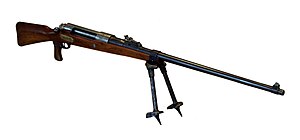Mauser 1918 T-Gewehr
| Mauser Mod. 1918 13.2 mm Tankgewehr | |
|---|---|

13.2 mm Rifle Anti-Tank at the Musée de l'Armée in Paris
|
|
| Type | Anti-tank rifle, Anti-materiel rifle |
| Place of origin | German Empire |
| Service history | |
| In service | 1918–1933 |
| Used by |
German Empire Weimar Republic |
| Wars |
World War I German Revolution of 1918–19 |
| Production history | |
| Manufacturer | Mauser |
| Produced | January 1918 |
| Number built | 15,800 |
| Variants | M1918 shortened Magazine-fed |
| Specifications | |
| Weight | 15.9 kg (35 lb), 18.5 kg (41 lb) loaded with the bipod |
| Length | 169.1 cm |
| Crew | two man crew |
|
|
|
| Cartridge | 13.2 mm TuF (German: Tank und Flieger) |
| Caliber | 13.2 mm (.525 inches) |
| Action | bolt-action |
| Rate of fire | single shot |
| Effective firing range | 500 m |
| Feed system | manual |
| Sights | 100 – 500 m (notched V) |
The Mauser 13 mm anti-tank rifle (German: Tankgewehr M1918, usually abbreviated T-Gewehr) was the world's first anti-tank rifle—the first rifle designed for the sole purpose of destroying armored targets—and the only anti-tank rifle to see service in World War I. Approximately 15,800 were produced.
During the First World War the onset of static, trench warfare saw the rise in the use of armour plate for personal defence, and the development and use of armour-piercing ammunition to counter this. Both Britain and Germany used high-powered rifles, such as elephant guns from their African colonies, for this purpose. The first use of armoured fighting vehicles (tanks) was by the British at the Battle of Flers–Courcelette in September 1916 and were followed by the French. By June 1917, the German Army faced the Mark IV tank, and found that the standard armour-piercing 7.92 mm K bullet was no longer effective. This prompted the development by the Germans of a heavy-calibre and high-velocity rifle as an anti-tank weapon. The Mauser Company responded with the 13mm T-gewehr and began mass production at Oberndorf am Neckar in May 1918. The first of these off the production lines were issued to specially raised anti-tank detachments.
The rifle was a single-shot bolt-action rifle using a modified Mauser action, with rounds manually loaded into the chamber. The weapon had a pistol grip and bipod, but no method of reducing recoil, such as a soft buttpad or muzzle brake. This could cause problems for the shooter with repeated firing. The iron sights were composed of a front blade and tangent rear, graduated in 100-meter increments from 100 to 500 meters. The rifle was operated by a two-man crew of a gunner and ammunition bearer, who were both trained to fire the weapon. Due to the tremendous blunt force of the recoil, it was designed to be shot in a static position, either prone or from inside a trench.
...
Wikipedia
